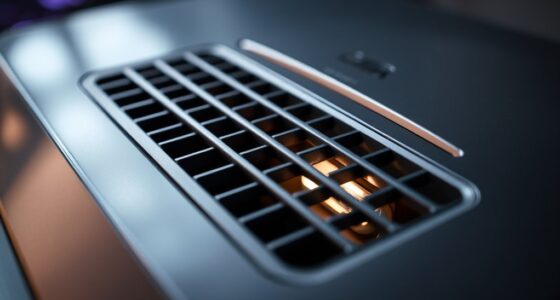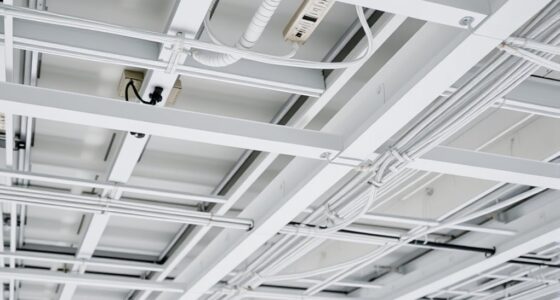To manage ceiling cables safely and stay compliant, you must follow local building codes and safety standards. Choose the right cables and hardware rated for your environment, and secure them properly with supports like clips and ties. Plan your layout carefully to maintain proper clearances and accessibility. Don’t forget permits and inspections—skipping these can lead to violations. Keep these tips in mind, and you’ll get a solid foundation for error-free cable management that meets all requirements.
Key Takeaways
- Prioritize secure, neat cable routing that complies with local height, clearance, and fire safety codes.
- Select hardware and cables rated for ceiling installations and adhere to industry standards for safety.
- Plan routes early, avoiding hazards, ensuring proper supports, and maintaining clearances for safety and aesthetics.
- Obtain necessary permits, conduct inspections, and keep detailed documentation to ensure ongoing compliance.
- Regularly verify modifications, follow updated codes, and use approved materials to prevent violations and ensure safety.
Understanding the Basics of Ceiling Cable Installation Regulations
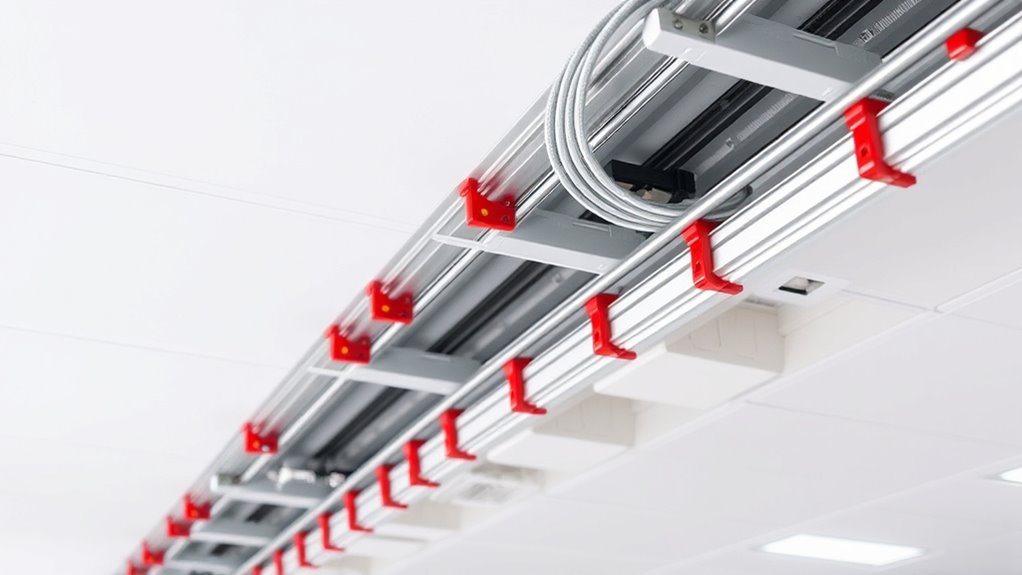
Have you ever wondered what rules govern ceiling cable installations? Regulations focus on safety, functionality, and appearance. While wireless alternatives are growing in popularity, many projects still require cables for power or data. These rules ensure cables are installed securely, avoiding hazards or damage. Aesthetic considerations also play a role; cables should be neatly concealed or arranged to maintain a clean look. Local building codes specify minimum clearance heights, support requirements, and fire safety standards. Understanding these basics helps you plan an installation that’s compliant and visually appealing. Familiarizing yourself with industry standards can further ensure your project meets all necessary safety and quality benchmarks. Ignoring regulations can lead to fines, safety issues, or costly rework. So, familiarize yourself with the relevant codes, prioritize safety, and consider the visual impact to create a professional, compliant ceiling cable setup.
Selecting the Right Cables and Hardware for Compliance
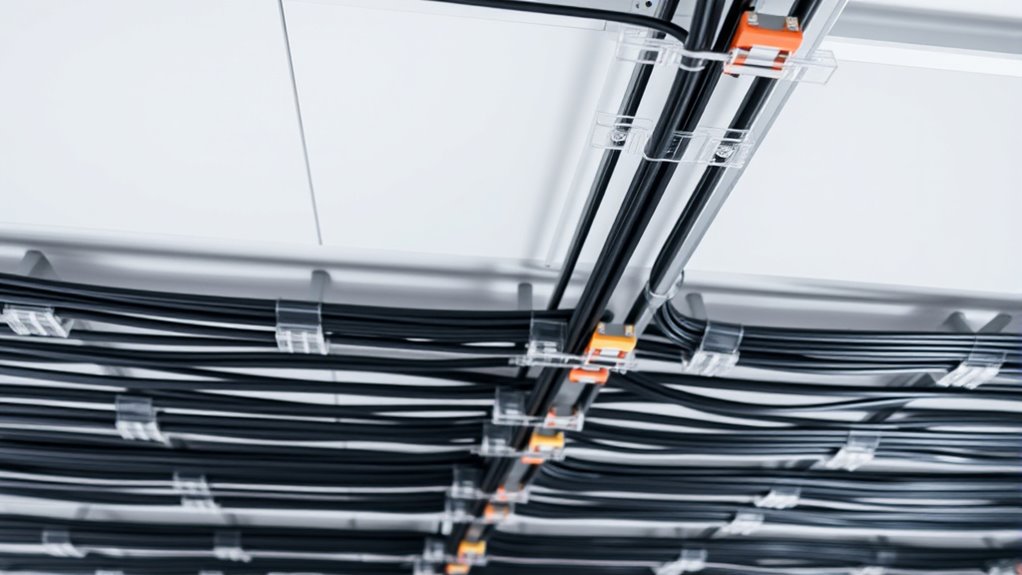
Choosing the right cables and hardware is key to ensuring your ceiling installation meets safety and compliance standards. Start by selecting the appropriate wire gauge; thicker gauges handle higher loads and reduce overheating risks. Confirm that your cables are rated for your specific environment and comply with local codes. Cable color coding is essential for easy identification and safety; for example, black or red wires typically carry power, while white or gray are neutral. Use hardware that is compatible with your cables, such as sturdy anchors and connectors that meet industry standards. Proper hardware prevents strain and movement, maintaining code compliance. Always verify that your chosen cables and hardware are approved for ceiling installations, ensuring both safety and adherence to regulations.
Planning Your Layout to Meet Building Codes

Are you aware of the specific building codes that govern ceiling cable installations in your area? Proper planning is vital to guarantee your layout complies with these regulations. Start by mapping where lighting fixtures will go, considering both function and aesthetic considerations. Keep clearances in mind, avoiding overlaps with HVAC or fire safety systems. Determine cable routing paths that minimize visual clutter and meet code requirements for clearance and accessibility. Check local regulations for height restrictions or specific conduit requirements, especially around electrical boxes and junction points. Incorporate your lighting fixtures into your plan early, making sure cables are concealed and supported properly. This careful planning helps you meet code standards while achieving a clean, professional ceiling appearance. Additionally, understanding cable management best practices can improve safety and ease future maintenance.
Proper Support and Securing Methods for Ceiling Cables
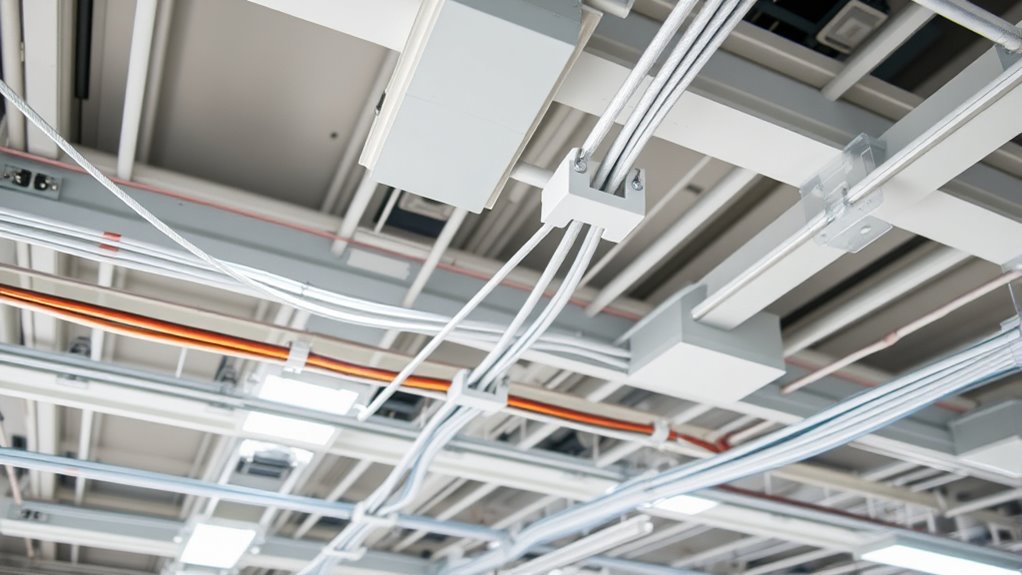
Proper support and securing methods are essential to guarantee ceiling cables stay in place and meet safety standards. Using appropriate fasteners and supports prevents sagging and accidental damage, ensuring cable concealment and aesthetic integration. Secure cables at regular intervals, following local codes, to avoid strain and movement. Choose proper anchors, clips, or ties that are rated for your cable type. To illustrate, consider this support method table:
| Support Type | Suitable For | Benefits |
|---|---|---|
| Cable Ties | Light cables | Easy installation |
| Conduit Clips | Heavy or multiple cables | Secure and organized |
| Mounting Brackets | Suspended ceilings | Reliable support |
| Cable Trays | Large cable runs | Improved cable management |
| Adhesive Clips | Temporary setups | Quick, non-invasive securing |
Ensuring Safe Clearances and Accessibility Standards
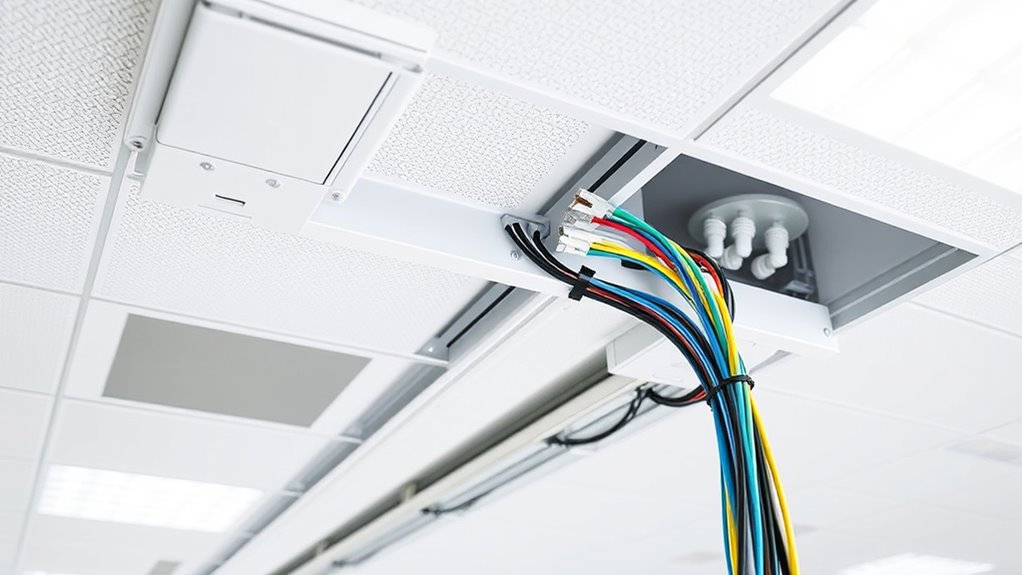
To guarantee electrical safety and ease of maintenance, maintaining appropriate clearances around ceiling cables is essential. Proper clearances prevent overheating, reducing fire safety risks, and ensure cables are accessible for inspection or repairs. You should follow local codes that specify minimum distances from lighting fixtures, vents, and structural elements. This not only helps meet safety standards but also improves aesthetics considerations by avoiding cluttered or tangled wiring. Keep cables away from high-traffic areas to prevent accidental damage, and ensure they’re visible enough for routine checkups. Adequate clearance also facilitates compliance with fire safety regulations, minimizing hazards in case of electrical faults. Regularly review your cable layout to confirm it aligns with current standards, maintaining both safety and a clean, professional appearance. Additionally, understanding Kia Tuning options can help you optimize your vehicle’s performance and aesthetics while adhering to safety regulations.
Navigating Permits and Inspection Processes
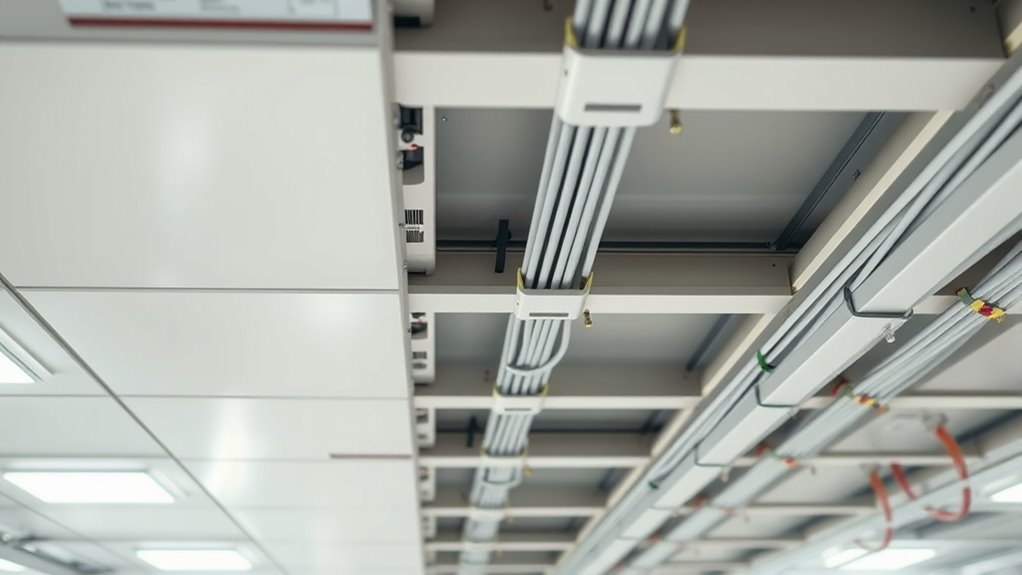
Before starting your ceiling cable project, you’ll need to understand the permit application procedures and what inspectors will review. Knowing the inspection requirements helps you prepare and avoid delays. Watch out for common compliance pitfalls that can hold up approval or lead to costly rework. Additionally, understanding Gold IRA regulations can be crucial if your project involves significant financial planning or investment considerations.
Permit Application Procedures
Understanding the permit application process for ceiling cable management can seem daunting, but grasping the steps involved makes it manageable. First, identify whether your project involves equipment upgrades that require permits. Check local codes for specific documentation requirements, which may include detailed plans, load calculations, and manufacturer specifications. Prepare all necessary paperwork before submitting your application to avoid delays. Make sure your drawings clearly show cable routes, support structures, and compliance measures. Submit your application to the appropriate authority, whether city or county, and pay any applicable fees. After submission, be prepared for possible follow-up questions or requests for revisions. Staying organized and informed about these procedures helps streamline approval, keeping your project on schedule and compliant with all relevant codes. Additionally, understanding juice detox side effects and shelf life can assist in planning safe and effective health routines around your project timeline.
Inspection Requirements Overview
Have you wondered what happens after submitting your permit application for ceiling cable management? During inspections, authorities verify that your installation meets fire safety standards and promotes energy efficiency. They’ll check that cables are properly secured, avoid fire hazards, and don’t obstruct ventilation or emergency systems. Inspectors also confirm that your setup complies with local codes, ensuring safety for everyone in the building. Be prepared to demonstrate adherence to regulations through documentation and on-site reviews. If issues arise, you’ll need to correct them before approval. Understanding these inspection requirements helps streamline the process, saving you time and effort. Remember, passing inspections is vital to maintaining a safe environment and ensuring your project remains compliant with all ceiling cable management standards. Proper project planning and adherence to guidelines can facilitate smoother inspections and successful project completion.
Common Compliance Pitfalls
One common compliance pitfall is failing to thoroughly understand and follow the specific permit requirements and inspection procedures in your area. Overlooking these steps can lead to delays or costly rework, especially if you’re unaware of local wiring codes or inspection standards. Additionally, neglecting aesthetic considerations can cause issues during approval, as inspectors often look for neat, unobtrusive cable management. Considering wireless alternatives can sometimes simplify compliance, reducing the need for extensive wiring and permits. However, if cables are necessary, ensure they’re properly documented and installed per regulations. It’s also important to stay informed about cybersecurity vulnerabilities that could impact your electrical system’s safety and compliance. Always double-check permit details and inspection checklists to avoid misunderstandings. Proactively addressing these factors helps ensure a smooth process and keeps your ceiling cable management both compliant and visually appealing.
Common Mistakes That Violations and How to Avoid Them
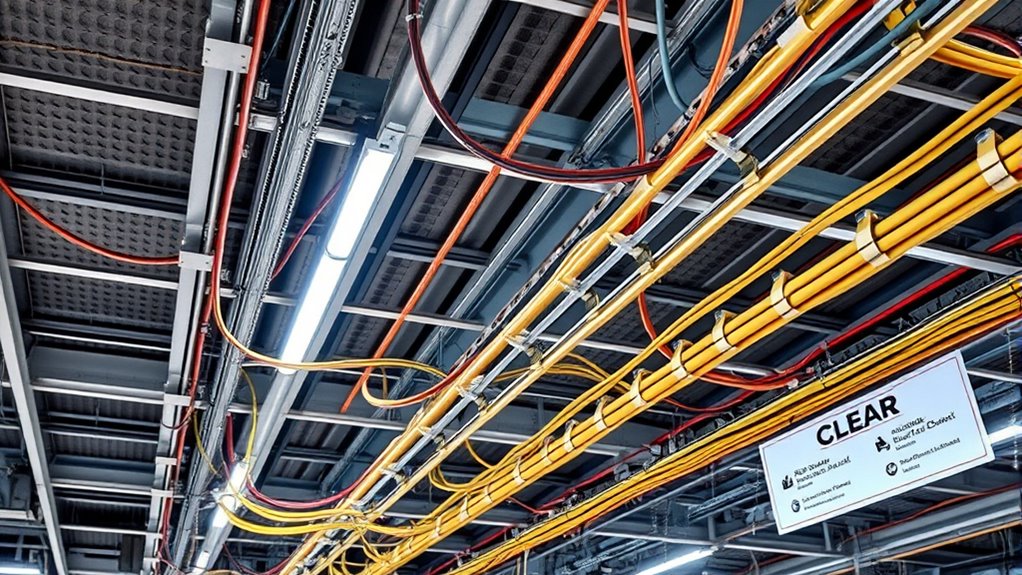
Many common mistakes in ceiling cable management often lead to violations that compromise safety and aesthetics. Ignoring proper planning can result in cluttered wiring, which hampers fire safety and looks unprofessional. To avoid this, focus on these key areas:
- Overloading circuits, risking fire hazards and code violations
- Neglecting proper securing methods, leading to loose cables and potential hazards
- Ignoring aesthetic considerations, creating an unappealing, chaotic ceiling appearance
- Failing to use diverse designs that match decor, which can make the installation look unprofessional and detract from the overall aesthetics.
Maintaining Compliance During Repairs and Upgrades

When performing repairs or upgrades to ceiling wiring, it’s important to verify you stay compliant with electrical codes and safety standards. This ensures fire safety and maintains the ceiling’s aesthetic appeal. To visualize, consider this table:
| Step | Focus Area | Key Tip |
|---|---|---|
| Inspect existing wiring | Fire safety | Check for damage or code violations |
| Upgrade components | Aesthetic considerations | Use matching fixtures to blend seamlessly |
| Follow code guidelines | Compliance | Double-check local regulations |
Additionally, always consult current building codes to ensure all modifications meet the latest safety standards.
Frequently Asked Questions
How Often Do Ceiling Cable Codes Get Updated?
You should check for cable code updates and ceiling code revisions at least every few years, as they typically get reviewed and revised regularly to guarantee safety and compliance. Local building departments and industry organizations usually update these codes based on new safety research or technological advances. Staying informed through official sources helps you keep your ceiling cable installations compliant and up-to-date with the latest standards.
Are There Specific Safety Certifications Required for Installation Tools?
You should always use tools with proper safety certifications, as studies show certified tools reduce workplace accidents by 30%. To guarantee safety standards are met, verify that your installation tools have relevant certifications like OSHA or UL markings. These certifications confirm the tools meet strict safety standards, helping you prevent hazards. Always choose certified tools for ceiling cable installation to protect yourself and ensure compliance with safety regulations.
Can DIY Installations Meet All Compliance Standards?
Yes, DIY installations can meet all compliance standards if you prioritize safety and use properly certified tools. Make sure your tools have the necessary certifications for safety and performance, and follow local codes carefully. Prioritize DIY safety by wearing protective gear and working methodically. Staying informed about the regulations and best practices guarantees your project is compliant, safe, and up to code.
What Are the Penalties for Non-Compliance in Ceiling Cable Codes?
Ignoring ceiling cable codes can lead to penalties so severe, they’ll feel like a legal hurricane hitting your project. You could face hefty fines that drain your budget faster than you can blink, along with potential legal actions that could shut down your work entirely. Non-compliance risks not only financial loss but also safety hazards, so it’s essential to follow regulations carefully to avoid these disastrous consequences.
How Do I Document My Compliance for Future Inspections?
To document your compliance for future inspections, keep thorough inspection records and maintain detailed compliance documentation. Record dates, inspection results, and any corrective actions taken. Store these records in an organized, accessible system, such as digital files or physical binders. Regularly update your documentation to reflect ongoing adherence to ceiling cable codes. This approach guarantees you can quickly prove compliance during inspections and avoid potential penalties.
Conclusion
Now that you know the essential steps for proper ceiling cable management, are you ready to tackle your project with confidence? Remember, overlooking even a small detail can lead to costly violations or safety issues down the line. Stay vigilant, follow the codes closely, and don’t cut corners. The next challenge awaits—will your installation pass inspection and stand the test of time? The choice is yours—are you prepared to do it right?


